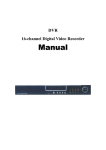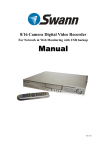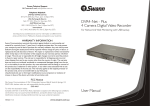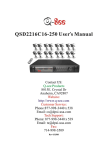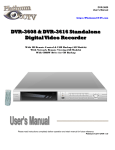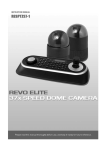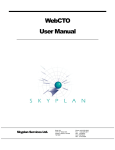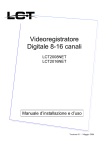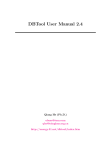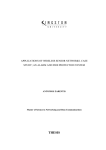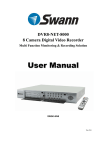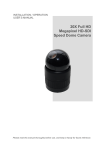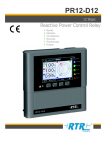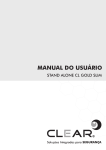Download User`s Manual
Transcript
8/16 Channel Digital Video Recorder QSNDVR8/16R Digital Video Recorder User’s Manual 1 8/16 Channel Digital Video Recorder Precautions & Safety Instructions Power Source This Digital-Video-Recorder uses an AC90-240 V power source. This recorder should only be operated using the specified power supply. Please check the voltage of the power supply before using. If you are not going to use the recorder for a long period of time, be sure to disconnect the power supply from the wall outlet. To disconnect the power supply, grasp the plug itself; never pull the cord. On Placement This recording unit is to be used and installed indoors. It must not be exposed to rain or moisture. Place the recorder in a location with adequate ventilation to prevent heat build-up in the recorder. Slots and openings in the cabinet are provided for ventilation to ensure reliable operation of the recorder and to protect from overheating. These openings must not be blocked or covered. Do not place the recorder on a soft surface such as a rug that might block the ventilation holes. Do not place the recorder in a confined space such as a bookshelf or similar type unit. Do not place the recorder in a location near heat sources such as a radiator or heat register. Do not place the recorder in a location subject to direct sunlight, excessive dust or mechanical shock. Object and Liquid Entry Should any solid object fall into, or liquid spill into the cabinet, unplug the recorder and have it checked by qualified service technicians before operating it any further. Servicing This Digital-Video-Recorder is a precision instrument. In case of damage or malfunction of the recorder have it repaired by qualified service technicians or contact the dealers in your area. Do not attempt to make the repairs yourself. Copyrights Television programs, films, video tapes, discs, and other materials may be copyrighted. Unauthorized recording of such materials may be contrary to the provisions of the copyright laws. 1 8/16 Channel Digital Video Recorder Features Video input: 8/16channels; video output: 3 Audio input: 4channels; audio output: 1 Four levels of image quality: very high, high, normal, low. Record and playback frame rate is changeable for recording. Compression standard: MJEPG NTSC / PAL Compatible. Supports alarm recording and set times recording. Multi-function searches: Identifies and sorts various alarm records and time records from routine recording; search by time, by segment or by event. Playback modes: pause, variable fast forward and reverse play modes. Zoom, auto function, watermark security 8/16 alarm input and 1 relay alarm output. Remote control and PTZ control enabled. Loss and motion detection functions. Triplex operation, play back and search while recording. Supports network viewing. Archiving via USB and CD-RW 480 fps Display Speed (Compared to NTSC/PAL, 400 fps). Up to 120 fps Recording Speed (Compared to NTSC/PAL, 100 fps). 2 8/16 Channel Digital Video Recorder Table of Contents SYSTEM CONNECTIONS.............................................................................5 1. REAR PANEL AND CONNECTION TERMINALS ....................................................................................... 5 2. VIDEO AND AUDIO CONNECTIONS ....................................................................................................... 5 3. ALARM AND SENSORS CONNECTION ................................................................................................... 6 4. HARD DISK (HDD) CONNECTION ........................................................................................................ 8 SYSTEM SETUP............................................................................................10 1. ACCESSING MENUS............................................................................................................................ 10 2. SETUP OPTIONS ................................................................................................................................. 11 3. SYSTEM SETUP .................................................................................................................................. 11 4. TIME/DATE SET ................................................................................................................................. 12 5. HARD DISK (HDD) FORMAT SET ....................................................................................................... 13 6. FACTORY RESET................................................................................................................................. 13 7. MENU LANGUAGE ............................................................................................................................. 14 8. CHANGE PASSWORD .......................................................................................................................... 15 9. FIRMWARE UPDATE ........................................................................................................................... 16 10. DISPLAY SETUP ................................................................................................................................ 17 11. CAMERA NAME ................................................................................................................................ 18 12. COLOR SETUP .................................................................................................................................. 19 13. AUTOSEQ SETUP .............................................................................................................................. 19 14. RECORDING SETUP .......................................................................................................................... 20 15. REC CH SETUP ................................................................................................................................ 21 16. AUDIO CH SETUP ............................................................................................................................ 22 17. NETWORK SETUP ............................................................................................................................. 23 18. NETWORK ENABLE SETTING ........................................................................................................... 24 19. MAC (MEDIA ACCESS CONTROL) SET ............................................................................................. 24 20. SENSOR SETUP ................................................................................................................................. 25 21. MOTION DETECTION SETTINGS ....................................................................................................... 26 22. MOTION AREA SET .......................................................................................................................... 27 23. SCHEDULE SET ................................................................................................................................ 28 24. BACKUP SET .................................................................................................................................... 28 25. CD-RW BACKUP ............................................................................................................................. 30 26. DATA STORAGE INFO ....................................................................................................................... 32 27. PROTOCOL SET ................................................................................................................................ 32 3 8/16 Channel Digital Video Recorder FRONT PANEL BUTTONS..........................................................................34 1. RECORDING/PLAYBACK CONTROL BUTTONS .................................................................................... 34 2. FUNCTION CONTROLS AREA (16-CH DVR MODEL) ......................................................................... 35 3. FUNCTION CONTROLS AREA (8-CH DVR MODEL) ........................................................................... 36 4. CHANNEL SELECTION CONTROLS AREA (16-CH DVR MODEL)........................................................ 38 5. CHANNEL SELECTION CONTROLS AREA (8-CH DVR MODEL).......................................................... 39 USER GUIDELINE .......................................................................................40 1. TURNING THE DVR ON..................................................................................................................... 40 2. TURNING THE DVR OFF ................................................................................................................... 40 3. NORMAL RECORDING PROCESS ......................................................................................................... 40 4. ALARM RECORDING .......................................................................................................................... 41 5. TIME RECORDING .............................................................................................................................. 41 6. PLAYBACK ......................................................................................................................................... 42 7. SEARCH PLAY .................................................................................................................................... 43 8. TIME SEARCH .................................................................................................................................... 43 9. EVENT SEARCH .................................................................................................................................. 44 10. START/STOP SEARCH ....................................................................................................................... 45 11. USB DEVICE BACKUP ..................................................................................................................... 46 12. ZOOM OPERATION ........................................................................................................................... 47 13. INFORMATION DISPLAY ................................................................................................................... 47 14. PAN-TILT-ZOOM (PTZ) OPERATION ................................................................................................. 48 15. DEFAULT SETTINGS.......................................................................................................................... 49 16. REMOTE CONTROL .......................................................................................................................... 51 17. NETVIEWER SOFTWARE INSTALLATION AND OPERATION ................................................................ 52 STANDARD AND PRODUCT SPECIFICATIONS...................................57 EQUIPMENT AND ACCESSORIES SUPPLIED......................................58 APPENDIX A: Q&A TROUBLESHOOTING GUIDE..............................59 APPENDIX B: PROTOCOL FOR DVR CONTROL ................................62 APPENDIX C: RECORDING CAPACITY FOR 120GB HDD ................65 APPENDIX D: INTERNET VIEW/PLAYBACK CONFIGURATION...65 4 8/16 Channel Digital Video Recorder System Connections 1. Rear Panel and Connection Terminals Power cord, input and output signal terminals are all situated on the rear panel of the DVR. The connections to monitor(s), video cameras, and all external peripherals are also through the terminals and sockets on the rear panel. The rear view of the DVR is illustrated below. The 16 CH DVR configuration is shown; the 8 CH configuration is similar. The rear panel layout: 1: VIDEO INPUT 1-16 4: S-VIDEO 7: NET INTERFACE 10: DEBUG PORT 2: MAIN OUTPUT 5: AUDIO INPUT 8: USB PORT 11: FAN 3: ASSISTANT MONITOR 6: AUDIO OUTPUT 9: ALARM AND RS485 PORT (see Section 3) 12: POWER INPUT (DC12V) 2. Video and Audio Connection The DVR can support up to 16 camera’s video input simultaneously. Up to three monitors can be installed as shown in the diagram below. At least one monitor is to be installed for system setup which is described in the next section. 5 8/16 Channel Digital Video Recorder There are two steps for camera installation: 1. Connect the Video Signal Line to the DVR channel input. 2. Connect the power adaptor jack to the camera. The DVR can connect up to four channels for audio input, but only one can be selected for output and recording at any given time. To display the DVR image, the video output signal should be displayed to a TV set or monitor connected to the rear panel. Any TV set that has a “video input” terminal is suitable for displaying the image. The figure above shows the video and audio signal line connection. 3. Alarm and Sensors Connection (Requires professional installer) The DVR can support 16 alarm inputs and 3 alarm outputs. Alarm input: There are two types of alarm input. 1. Voltage output( 5V and 0V) A: If the sensor output is high voltage (5V) normally and output is low voltage (0V) when triggered, then users must set DVR as low voltage alarm. B: If the sensor output is low voltage (0V) normally and output is high voltage (5V) when triggered, then users must set DVR as high voltage alarm. Refer to the diagram below; Ch 2 to Ch 16 connectivity is similar to that for channel 1. 6 8/16 Channel Digital Video Recorder 2. Open/Close output A: N.O. Normal Open; closes when triggered. DVR must be set as low voltage alarm. B: N.C. Normal Close; opens when triggered. DVR must set as high voltage alarm. Please refer to the diagram below, channel 2 to channel 16 are similar to channel 1. Alarm output There are three alarm output pins, the status of these pins are illustrated below: A fte r al ar m B e for e ala r m N. O. COM N. C. N. O. COM N. C. 7 8/16 Channel Digital Video Recorder Example for alarm output connection: N. O. COM N. C. A la rm 5V Alarm and RS485 port pins are defined: 1 through 12: Sensor 1 through Sensor 12 20, 24, 25: GND 14 through 17: Sensor 13 through Sensor 16 18: RS485+ 19: RS48521: COM 22: NC 23: NO 4. Hard Disk (HDD) Connection THERE ARE TWO POSSIBLE PROCESSES TO INSTALL THE HARD DISK: Option 1. If the DVR comes without a CD-RW, please follow the following installation sequence: 1. Pull out the hard drive rack from the DVR side panel. 2. Open the top cover of the drawer. 3. Set jumper on HDD to MASTER 4. Connect the ribbon (IDE) cable & power cable. J u m p to M a s te r 8 8/16 Channel Digital Video Recorder 5. Close the top cover of the drawer and put the hard drive drawer back into the DVR. (Make sure the cables are firmly pressed onto the HDD interface) 6. Lock the hard disk drawer by turning the key clockwise. If you have another HDD, set the jumper on that HDD to SLAVE, open the DVR cover, put the HDD to a second HDD shelf, and then connect the power and ribbon cable. Option 2: If the DVR comes with a CD-RW, please follow the steps outlined below: Open the DVR cover, fix the HDD to the DVR HDD plate that supports the HDD, then connect the power and ribbon cable. When installing a second HDD, set the jumper on the first one to MASTER and the jumper on the second HDD to SLAVE; put that HDD on the other HDD shelf. Connect the power and ribbon cable. The process is similar as that for Option 1. 9 8/16 Channel Digital Video Recorder System Setup Prior to use, program the DVR with your desired settings, otherwise the DVR will run in the default settings. 1. Accessing Menus To access the menus in the 16CH DVR continuously press the Menu/Search button on the front panel, until the password input window appears. For the 8CH DVR just press the Menu button, the password input window will display. The password is a random combination of 4 digits, “0-9”. The default is “0000”. For security, as you input your password, “*” will display. If you input an incorrect password, the PASSWORD CHECK screen will automatically return. If you don’t want to input the password and cancel the operation, exit the system. To exit the system, it is not necessary to input your password, just press the menu button. To change the password, please refer to “password change”. After you enter the correct password, the main menu will display as shown below for “SETUP MODE”: 10 8/16 Channel Digital Video Recorder 2. Setup Options When in SETUP MODE, click on either the up or down arrow to scroll through the selection of settings. The selection will be highlighted in yellow. When selecting a digit for items such as year, month, day, hour, minute, second, etc, click on the left or right arrow. To change a value you must press the ADD or DEC button. DEC stands for decrease. These buttons are accessed on the front DVR panel or correspond to the “-SET+” button on the remote control. Click on ENTER to enter a sub menu and click on MENU to return to the previous menu. 3. System Setup To access System Setup, select SYSTEM SET and click on ENTER. The SYSTEM SETUP window will appear. This is illustrated below: 11 8/16 Channel Digital Video Recorder VIDEO SYSTEM: To set up the video format, NTSC or PAL BUZZER SOUND: Buzzer switcher. If set to “OFF”, the buzzer will not work.. 4. Time/Date Set Move the cursor to TIME/DATE SET, press ENTER and the TIME/DATE SETUP window will appear as shown below. Please note if the DVR is in recording mode you cannot access this menu unless you stop recording first. . Press UP, DOWN, LEFT, and RIGHT buttons to move the cursor. Press ADD or DEC buttons in the front panel (or “-SET+” on the remote control) to set up the DATE and TIME values. 12 8/16 Channel Digital Video Recorder FORMAT: The time display format, which is different for USA, Europe and Asia users. DISPLAY: If set to “OFF”, time will not display on the screen. LOCAL: Time display position in the cameras’ video output. 5. HDD Format Set Move the cursor to HDD FORMAT SET, press ENTER and the HDD Format Setup window will appear to confirm this operation. This is illustrated below: If “YES” is selected and ENTER is pressed to confirm, all video files on the HDD will be lost in the reformatting process. Select “NO” to skip this operation. 6. Factory Reset In the SYSTEM SETUP menu window, select FACTORY RESET then ENTER and the following window will appear as illustrated below: 13 8/16 Channel Digital Video Recorder If “YES” is selected and the ENTER button is pressed, the DVR will reset to default factory settings. To skip this operation, select “NO” and hit ENTER. 7. Menu Language Move the cursor to MENU LANGUAGE, press the ENTER button and the MENU LANGUAGE window will appear. This is illustrated below: Push “-SET+” on the remote control or ADD/DEC in the front panel to change the interactive language settings. 14 8/16 Channel Digital Video Recorder 8. Change Password Move the cursor to CHANGE PASSWORD, press ENTER and the CHANGE PASSWORD window will appear as illustrated below: Password Level: The DVR has different types of passwords that can be setup: SETUP: If set to “YES”, a password must be input to enter the menu. SYSTEM: If set to “YES”, a password must be input to boot the DVR. RECORD: If set to “YES”, a password must be input to stop manual recording. SCHEDULE: If set to “YES”, a password must be input to cancel schedules. If you select the PASSWORD CHANGE and press the ENTER button, PASSWORD CHANGE window will display as shown below: 15 8/16 Channel Digital Video Recorder Enter the current password, then input a new password and then confirm the new password. 9. Firmware Update Move the cursor to FIRMWARE UPDATE in the main SYSTEM SETUP menu window, press the ENTER button and the update window will appear. This is illustrated below: Updating Methods: There are two methods to update the system: USB and NETWORK (currently not supported). USB UPDATE: Create a new folder named “firmware” in the USB device‘s root directory, copy the update file to the folder, plug in the USB device to the DVR, enter this menu and select UPDATE START and press the ENTER button. The system will start updating. When updating is completed, the window 16 8/16 Channel Digital Video Recorder will display as shown below. Manually reboot the DVR. To reboot the system simply unplug the power cable and then plug it back. 10. Display Setup Move the cursor to DISPLAY SETUP, press the ENTER button and the DISPLAY SETUP menu window will appear. This is illustrated below. The BOUND COLOR (Boundary Color) and BLANK COLOR settings define colors for border lines between split screens and inactive screens. 17 8/16 Channel Digital Video Recorder 11. Camera Name Move the cursor to CAMERA NAME. Press the ENTER button, the camera NAME SETUP window will appear. This is illustrated below for seven channels (CH01 to CH07) as an example: Pressing the up button or down button (arrow up or arrow down) will select the channels separately. Press the ENTER button to change each channel’s name as shown below. Each channel’s name is the combination of up to eight characters. Pressing the left arrow or right arrow buttons will select each character. Pressing the ADD or DEC button selects characters for the name. 18 8/16 Channel Digital Video Recorder When the name setup for each channel is completed press the ENTER button to save this name. Note: When DISPLAY is set to “OFF”, the channel’s name will not display on the screen. 12. Color Setup Move the cursor to COLOR SET, press the ENTER button and the COLOR SETUP window will appear as illustrated below. Colors can be adjusted separately for each channel for the following four options: CON: Picture Contrast BRI: Picture Brightness HUE: Picture Hue SAT: Picture Saturation Press the left or right arrow buttons to select separately CON/BRI/HUE/SAT. Pressing ADD or DEC will adjust the values. Pressing ADD or DEC on the channel name will change the channel. The process is repeated for each channel for color adjustment. 13. Autoseq Setup Autosec will display one camera at a time at specific intervals. Move the cursor to AUTOSEQ SET in the DISPLAY SETUP menu, pressing the ENTER button will result in the AUTOSEQ SETUP window appearing. This is illustrated below: 19 8/16 Channel Digital Video Recorder Press up button or down button arrows to select each channel separately. Press the ADD or DEC button to change Auto Sequence time for each channel. 14. Recording Setup Move the cursor to RECORD SET in the main SETUP MODE menu, pressing the ENTER button will result in the RECORD SETUP window appearing. This is illustrated below. Press the up or down arrow buttons to move the cursor. Press the “-SET+” button on the remote control or the ADD or DEC button in the front panel to change the value. Note: While the DVR is in recording or playback mode, you cannot access this menu unless you stop recording or playback first. OVER WRITE: If set to YES, the DVR will automatically overwrite the HDD when the HDD is full. If 20 8/16 Channel Digital Video Recorder set to NO, the DVR will automatically stop recording when the HDD is full. If there are two HDDs installed in the DVR, when the MASTER HDD is full, the video will store to the SLAVE HDD. When the SLAVE HDD is full, the DVR will overwrite the MASTER HDD if OVER WRITE is set to YES, otherwise recording will stop. REC SPEED: The DVR factory default setting for the recording frame rate is 30F/SEC (frames/second) under video standard NTSC (25F/SEC default under video standard PAL). This means the DVR records events at the speed of 30 frames per second. The higher the recording speed rate, the more natural look is displayed on the screen during playback. The lower the recording frame rate, the more space is saved on the hard disk. The highest frame rate is 120F/SEC for NTSC (for PAL is 100F/SEC) when the resolution is set as 360. REC QUALITY: There are four different video quality settings: VERY LOW, LOW, NORMAL and HIGH. The higher the video quality is set, the clearer images are obtained during playback. The lower the video quality is set, the more space is saved on the hard disk drive. RESOLUTION: The recording picture size of the DVR has two modes: 360 and 720. The default value is 360. In 720 mode, the recorded picture is twice as large as in 360 mode. In 360 mode the REC speed is 120F/SEC for NTSC (100F/SEC for PAL) and the maximum REC SPEED in 720 mode is 60F/SEC for NTSC (50F/SEC for PAL). PB SPEED: The default playback frame rate is AUTO, which is the same as REC SPEED. Otherwise, there are also nine options to choose from: 1/2/3/5/12/20/30/60/120 F/SEC for NTSC standard (1/2/3/5/10/12/25/50/100 F/SEC for PAL). 15. Rec CH Setup Move the cursor to REC CH SET in the RECORD SETUP menu, pressing the ENTER button results in the REC CH SET window appearing. It is different for 720 and 360 resolutions. For 720 resolution, the setup window is illustrated below. Press the up or down arrow buttons to select each channel separately. Press the ADD or DEC buttons in the front panel (“-SET+”on the remote control) to change the setting. If any channel is set to OFF, this channel will not be active in recording mode. 21 8/16 Channel Digital Video Recorder Note: If the resolution is set to 360, the REC CH SET window can not be setup. 16. Audio CH Setup Move the cursor to AUDIO CH SET in the RECORD SETUP menu, pressing the ENTER button results in the AUDIO CH SET window appearing. This is illustrated below. There are four Audio Input channels. For each channel, any four of the 8 or 16 channels available (depending on the DVR model) can be selected. Although there are four Audio Input channels, you can only record one channel’s audio at any given time. To set the audio recording correctly select only one channel, among these four Audio Input channels, in the RECORD SETUP menu under AUDIO CH SET. 22 8/16 Channel Digital Video Recorder 17. Network Setup (May require IT expertise) Move the cursor to NETWORK SET in the SETUP MODE Top Main Menu, pressing the ENTER button results in the NETWORK SETUP menu window appearing. This is illustrated below. Note: If the Netviewer software is accessing the DVR, this menu cannot be accessed unless the Netviewer software is closed. IP MODE: the DVR has 2 IP mode options: STATIC IP and DHCP. If STATIC IP is selected, the IP ADDR (IP Address) is input manually. If the DHCP mode is selected, the DVR will automatically get the IP address from the network.. For STATIC IP, pressing up, down, left or right arrow buttons moves the cursor among the digits for each IP ADDR, GATEWAY and SUB NET. Pressing the ADD and DEC buttons in the front panel modifies the digits. To select each digit press the ENTER button, the left or right arrow buttons to move to the next one, press ADD or DEC button to modify any digit and press ENTER to save the selected number or the change. NETWORK ENV: The DVR has three types of different network options: LOCAL, EXTER_LAN and EXTER_WAN. If in a local network, please select LOCAL; for internet use, please choose EXTER_LAN and if the internet condition is not very reliable, select EXTER_WAN. VIDEO PORT: The video transmit port number for the computer. COMMAND PORT: The command transmit port number for the computer. If you change the VIDEO PORT, COMMAND PORT or MAC address, you have to restart the DVR to use the Netviewer software provided. The MAC (Media Access Control) address is a unique value associated with a network adapter. MAC addresses are also known as hardware addresses or physical addresses. They uniquely identify an adapter on a LAN. 23 8/16 Channel Digital Video Recorder Note: If the MAC address has been changed, the MAC ADDR SET line is not visible. 18. Network Enable Setting Move the cursor to N/W Enable in the NETWORK SETUP menu, pressing the ENTER button results in the NET CH SETUP window appearing. This is illustrated below. Any active channel set to OFF results in this channel not transmitting to the network. To see a channel from the network, the channel must be set to ON. 19. Mac (Media Access Control) Set (May require IT expertise) Move the cursor to MAC ADDR SET in the NETWORK SETUP menu, pressing the ENTER button results in the MAC ADDR SET window appearing. This is illustrated below: 24 8/16 Channel Digital Video Recorder If there is more than one DVR in a local area network, each DVR must be set to have an exclusive MAC Address. There is only one chance to modify the MAC Address. Once the MAC ADDRESS is changed, this menu will not appear again. If you want to change the MAC ADDRESS again, the factory default settings have to be reloaded with Factory Reset. Move the cursor to FACTORY RESET in the SYSTEM SETUP menu, pressing ENTER will prompt you to INITIALIZE. Enter YES, DVR settings revert to default. MAC addresses are 12-digit hexadecimal numbers (48 bits in length). For MAC ADDRESS set the first two byte sets to 00.00, and change the other bytes. 20. Sensor Setup Move the cursor to SENSOR SET in the SETUP MODE Top Main Menu, pressing the ENTER button results in the SENSOR SETUP menu window appearing. This is illustrated below. Press up or down arrow buttons to move the cursor. Press the ADD or DEC buttons in the front panel (“-SET+”on the remote control) to change the setting. Setup individually, for each channel with sensor, using CHANNEL SELECT. The following Setup Options are available for each selected channel: ALARM ENABLE: Alarm trigger switch that can be set to OFF, LOW LEVEL or HIGH LEVEL; if set to OFF, the DVR will ignore the alarm input. MOTION ENABLE: Motion alarm switch that can be set to ON or OFF; if set to OFF, the motion alarm will be ignored. MOTION LEVEL: Motion sensitivity level. If the moving object in the picture is small relative to the screen output, set to HIGH or VERY HIGH. The default level is NORMAL. BUZZER TIME: Buzzer sound duration when there is a sensor or motion alarm triggered. 25 8/16 Channel Digital Video Recorder SENSOR RECTIME: When a motion or sensor alarm occurs, the duration of the DVR recording by default is 60 Sec. You can change this with this menu option. SCREEN SWITCHTIME: If set to ON, when there is an alarm on any one channel, the screen will automatically switch to full screen mode from that video channel. Note: Users should activate Schedule Set explained below after setting up these parameters to activate the settings. 21. Motion Detection Settings 1) When surveying nearby objects (2-10 meters) For daytime hours, set the MOTION LEVEL detection sensitivity to NORMAL; at night set to LOW. 2) When surveying objects in 50-100 meters distance The objects 50-100 meters away will appear quite small on the screen. For daytime hours, set the motion detection sensitivity to HIGH level. During nighttime hours (see below), set to the NORMAL level. 26 8/16 Channel Digital Video Recorder Note: The above suggestions are the result of extensive testing. The user can select the best settings for the actual operational environment. 22. Motion Area Set Move the cursor to MOTION AREA SET in the SENSOR SETUP menu, pressing the ENTER button will result in the image for AREA SETUP appearing. This is illustrated below. Pressing the up, down, left, right arrow buttons moves the cursor throughout the grid areas. Pressing the ENTER button toggles the grid areas between yellow (enabled) and gray (disabled). To copy the areas grid condition to adjacent square grid areas press ENTER continuously. The grid areas set to yellow are motion detection enabled; the ones set to gray are motion detection disabled. 27 8/16 Channel Digital Video Recorder 23. Schedule Set Move the cursor to SCHEDULE SET in the SETUP MODE Top Main Menu, pressing the ENTER button results in the SCHEDULE SETUP menu window appearing. This is illustrated below: The weekly recording schedule is setup for a period of time each day, from Monday to Sunday. START: Start recording time STOP: Stop recording time Note: Manual record mode (activate recording at any time) and Schedule record mode (including motion detection record mode, sensor record mode and time schedule record mode) are not active simultaneously. Once users select a Schedule record mode, manual record mode will be disabled; once users select manual record mode, schedule record mode will be disabled. 24. Backup Set Move the cursor to BACKUP SET in the SETUP MODE Top Main Menu, pressing the ENTER button results in the BACKUP SET window appearing. This is illustrated below. The CD-RW backup function is selectable when a CD-RW is installed. 28 8/16 Channel Digital Video Recorder There are two types of backup modes: USB and CD-RW (optional). If USB BACKUP is selected, plug in the USB device first, then press the ENTER button. The USB BACKUP window appears. This is illustrated below: There are two types of BACKUP MODE: STILL and MOVIE. STILL mode will backup still pictures; MOVIE mode will backup real video. Press ADD or DEC buttons in the front panel or –SET+ on the remote control to set the mode. To backup to the USB Port on the DVR a USB Flash Memory Card is normally used. To backup with USB Flash, plug the device to the USB port in the back of the DVR. The USB Flash should be detected. As mentioned above, still pictures or movie can be backed up. Search and playback the video files or set 29 8/16 Channel Digital Video Recorder the frames to watch. This is further explained in the User Guideline. The images are backed up to the USB Flash device. To Playback the files, connect the USB Flash to a PC and run the Network Viewer program. On the PC do a HDD scan, click on Local Search and click on Open Folder and select the Flash Drive. Select the files and click on PLAY in Network Viewer. 25. CD-RW Backup This function is only selectable if the DVR has a CD-RW installed. Pressing ENTER results in the CD_RW BACKUP menu appearing as shown below. START TIME SET: To set the backup start time. START: Backup start time display. END: Backup end time display. BACKUP START: To start backup to CD-RW. Selecting START TIME SET and pressing the ENTER button results in the BACKUP START SEARCH window appearing. This is illustrated below. This operation is similar to Time Search in the User Guideline section. The start time to backup is selected. 30 8/16 Channel Digital Video Recorder Once the backup start time is selected, the backup size can also be input. The backup size can be set from 1MB to 650MB. When these steps are completed, place a recordable CD in the CD-RW and select BACKUP START. The CD_RW BACKUP window is illustrated below: When backup is finished, from the Net Viewer software, use the Drive Scan function to playback the video. 31 8/16 Channel Digital Video Recorder 26. Data Storage Info Move the cursor to STORAGE INFO in the SETUP MODE Top Main Menu, pressing the ENTER button results in the STORAGE INFO window appearing. This is illustrated below. The HDD information is displayed. 27. Protocol Set (Requires IT expertise) For “speed dome cameras”, pan, tilt, zoom, etc. functions must be set up. If protocol is set correctly, the speed dome parameters for each camera can be controlled by the DVR. Move the cursor to PROTOCOL SET in the SETUP MODE Top Main Menu, pressing the ENTER button results in the PROTOCOL SET window appearing. This is illustrated below. Press up or down arrow buttons to move the cursor, and press “-SET+” on the remote control or ADD or DEC in the front panel to set the values for each channel. 32 8/16 Channel Digital Video Recorder CHANNEL SEL: Channel which is connected to the speed dome camera to control BAUDRATE: Changeable from 1200bps to 19200bps.The default value is 2400bps. DOME ADDR: Address of the speed dome, changeable from 0x00 to 0xff. PROTOCOL: Protocol of speed dome; includes PELCOP, PELCOD, NEON, and LILIN. DVRPROTOCOL: Protocol suitable for computer/keyboard control of the DVR. See App. A. DVRADDRESS: Address of the DVR for DVRPROTOCOL: From 0x00 to 0xff DVRBAUDRATE: The baud rate of the DVR for DVRPROTOCOL. 33 8/16 Channel Digital Video Recorder FRONT PANEL BUTTONS The front view of the video-recorder is illustrated below: 1.Recording/Playback Control Buttons 1. REC: This is the manual recording button. Press this button to record, if you re-press this button, it will stop recording. This function may require a password (if setup). This button is the toggle control for manual recording and stop recording operations. Recording and Stop will be simultaneous for all active channels up to 16 channels. This button will not work when Schedule Mode is set. 2. PLAY: Press this button to start playing the video stored in the HDD, press this button again and it will stop playing. This button is the toggle control for playing and stopping playback operations. Play and Stop will be simultaneous for all active channels. This button will not work during Time Set recording and during Alarm triggered recording. 3. REW: Rewind button. Press this button to start fast backward search playing until the PLAY button is pressed to start normal playing. 4. FORWARD: Fast forward button. Press this button to start fast forward playing until the PLAY button is pressed to start normal playing The fast forward function has five speeds; each time the FORWARD button is pressed changes the forward speed to the next fastest level.. 5. MODE: Mode change key. Press this key to switch to Shift Mode, press again to change back to Normal Mode. 34 8/16 Channel Digital Video Recorder 2. Function Controls Area (16-CH DVR Model) 1. Auto/1: Auto key. In shift mode, pressing this button puts the DVR in auto sequence mode. Sequences each channel image for the duration set in the AUTO SEQ setup menu. Press this button again to quit this mode. If not in shift mode, press this button to see Channel 1 full screen. When inputting numbers this button is used to key in number “1”. 2. Zoom/2: Zoom key. In shift mode, pressing this button puts the DVR in zoom mode. Refer to Zoom Operation in the User Guideline section for details. Press this button again to cancel the zoom operation. If not in shift mode, press this button to see Channel 2 full screen. When inputting numbers this button is used to key in number “2”. 3. USB/3: USB key. In shift mode, pressing this button starts USB backup. Refer to USB Device Backup in the User Guideline section for details. If not in shift mode, press this button to see Channel 3 full screen. When inputting numbers this button is used to key in number “3”. 4. Display/4: Display key. In shift mode, pressing this button displays current information on the screen, pressing again clears the information display. If not in shift mode, press this button to see Channel 4 full screen. When inputting numbers this button is used to key in number “4”. 5. Freeze/5: Freeze (pause) key. In shift mode, pressing this button puts the DVR in freeze mode. Press this button again to quit freeze mode. If not in shift mode, press this button to see Channel 5 full screen. When inputting numbers this button is used to key in number “5”. 6. Schedule/6: Schedule key. In shift mode, press this button to enter the Schedule Set state set up in the SCHEDULE SETUP menu. If the DVR is in schedule state, there will be an “S” symbol on the screen. Press this button again to quit schedule mode. If not in shift mode, press this button to see Channel 6 full screen. When inputting numbers this button is used to key in number “6”. 7. ADD/7: Add key. Press this button to see Channel 7 full screen. When in System Setup menus, this is an “increase” button. When inputting numbers this button is used to key in number “7”. 8. DEC/8: Decrease key. Press this button to see Channel 8 full screen. When in System Setup menus, this is a “decrease” button. When inputting numbers this button is used to key in number “8”. 9. SR/9: Single Frame Rewind button. In shift mode, during playback, press and hold this button to 35 8/16 Channel Digital Video Recorder see single frames running backwards. Press the PLAY button to play normally. If not in shift mode, press this button to see Channel 9 full screen. When inputting numbers this button is used to key in number “9”. 10. Sf/0/10: Single Frame Forward button. In shift mode, during playback, press and hold this button to see single frames running forward. Press the PLAY button to play normally. If not in shift mode, press this button to see Channel 10 full screen. When inputting numbers this button is used to key in“0”. 11. WM/10+: Watermark button. In shift mode, if the DVR is playing video, press this button to see the watermark symbol (WM) of the picture. If the video was recorded by this DVR and has not changed there will be the watermark symbol in the picture. Pressing the watermark key again clears the display. If not in shift mode, press and hold this button and then press 1 to 6 to see Channel 11 to Channel 16 full screen. 12. Menu/Search: Press this key to enter the Search Mode menu. See sections Search Play, Time Search, Event Search and Start Stop Search in the User Guideline for further details. Press and hold this key to enter the SETUP MODE Top Main Menu (a password is needed). Press this key again to quit any active menu on the screen. 3. Function Controls Area (8-CH DVR Model) 1. Auto/1: Auto key. In shift mode, pressing this button puts the DVR in auto sequence mode. Sequences each channel image for the duration set in the AUTO SEQ setup menu. Press this button again to quit this mode. If not in shift mode, press this button to see Channel 1 full screen. When inputting numbers this button is used to key in number “1”. 2. Zoom/2: Zoom key. In shift mode, pressing this button puts the DVR in zoom mode. Refer to Zoom Operation in the User Guideline section for details. Press this button again to cancel the zoom operation. If not in shift mode, press this button to see Channel 2 full screen. When inputting numbers this button is used to key in number “2”. 3. USB/3: USB key. In shift mode, pressing this button starts USB backup. Refer to USB Device Backup in the User Guideline section for details. If not in shift mode, press this button to see Channel 3 full screen. When inputting numbers this button is used to key in number “3”. 36 8/16 Channel Digital Video Recorder 4. Freeze/4: Freeze (pause) key. In shift mode, pressing this button puts the DVR in freeze mode. Refer to Freeze Operation in the User Guideline section for details. Press this button again to quit freeze mode. If not in shift mode, press this button to see Channel 4 full screen. When inputting numbers this button is used to key in number “4”. 5. Stop/5: Stop key. In shift mode, pressing this button, causes the DVR to stop recording and playing. If not in shift mode, press this button to see Channel 5 full screen. When inputting numbers this button is used to key in number “5”. 6. WM/6: Watermark button. In shift mode, if the DVR is playing video, press this button to see the watermark symbol in the picture (WM). If the video was recorded by this DVR and has not changed, there will be the watermark symbol in the picture. Pressing the watermark key again clears the display. If not in shift mode, press this button to see Channel 6 full screen. When inputting numbers this button is used to key in number “6”. 7. ADD/7: Add key. Press this button to see Channel 7 full screen. When in System Setup menus, this is an “increase” button. When inputting numbers this button is used to key in number “7”. 8. DEC/8: Decrease key. Press this button to see Channel 8 full screen. When in System Setup menus, this is a “decrease” button. When inputting numbers this button is used to key in number “8”. 9. Display/9: Display key. In shift mode, pressing this button displays current information on the screen, pressing again clears the info display. When inputting numbers this button is used to key in number “9”. 10. Schedule/0: Schedule key. In shift mode, press this button to enter the Schedule Set state set up in the SCHEDULE SETUP menu. If the DVR is in schedule state, there will be an “S” symbol on the screen. Press this button again to quit schedule mode. When inputting numbers this button is used to key in number “0”. 11. Menu: Press this key to enter the Search Mode menu. Press and hold this key to enter the SETUP MODE Top Main Menu (a password is needed). Press this key again to quit any active menu on the screen. 12. Search: Press this key to enter the Search Mode menu. See sections Search Play, Time Search, Event Search and Start Stop Search in the User Guideline for further details. 37 8/16 Channel Digital Video Recorder 4. Channel Selection Controls Area (16-CH DVR Model) 1. Full Screen/UP: Press this button to see full screen, press this button again to see the next channel. While selecting menu items, press this button to move the cursor up. 2. Four Pictures/DOWN: Press this button to see a four pictures display, press this button again to display next four pictures. While selecting menu items, press this button to move the cursor down 3. Nine Pictures/LEFT: Press this button to see a nine pictures display, press this button again to see eight pictures. While selecting menu items, press this button to move the cursor to the left. 4. Sixteen Pictures/RIGHT: Press this button to see a sixteen picture display, press this button again to see thirteen pictures. While selecting menu items, press this button to move the cursor to the right. 5. ENTER: While selecting menu items, press this button to select the item. When playing video press this button to pause the play, press the PLAY button to continue play. Sample multi-screen views: 38 8/16 Channel Digital Video Recorder 5. Channel Selection Controls Area (8-CH DVR Model) 1. Full Screen Add/UP: Press this button to see full screen, press this button again to see the next channel. When selecting menu items press this button to move the cursor up. 2. Full Screen Dec/DOWN: Press this button to see full screen, press this button again to see the previous channel. When selecting menu items press this button to move the cursor down. 3. Four Pictures/LEFT: Press this button to see a four pictures display, press this button again to see the next four pictures. When selecting menu items press this button to move the cursor to the left. 4. Eight Pictures/RIGHT: Press this button to see an eight pictures display. When selecting menu items press this button to move the cursor to the right. 5. ENTER: While selecting menu items, press this button to select the item. When playing video press this button to pause the play, press the PLAY button to continue play. 39 8/16 Channel Digital Video Recorder USER GUIDELINE 1. Turning the DVR ON The contents in the “Precautions and Safety Instructions” at the beginning of this manual must be understood and always complied with. Read this section carefully. Before turning the DVR ON, check the system connections. All input and output peripherals and devices must be properly and securely connected. Ensure that the DVR’s video format (NTSC/PAL) and the monitor(s) video format (NTSC/PAL) meet the technical requirements of each and are properly installed. Turn on all exterior equipment after checking their connectivity and settings that are not controlled by the DVR. If required, insert and connect the removable hard disk to the DVR and lock it up (turn the hard disk lock to the right-clockwise). Plug the power cord into an AC90-240 outlet and press the power switch ON in the front panel. 2. Turning the DVR OFF Normally turn OFF the DVR when the system shuts down according to schedule or is idle (not recording or playing). Do not turn off the DVR while playing, during playback or at any stage of System Setup taking place. Do not turn off the DVR while recording Press the recording REC button to stop recording or press the PLAY button to stop playing or exit from the System Setup menu before turning the power OFF. If the DVR will not be used for a long time, also disconnect the power cord from the electrical outlet. 3. Normal Recording Process Turn power ON to DVR and all related peripheral devices (cameras, monitor). there is video input. Press the DISPLAY button to check the amount of spare space on the hard disk. If there appears to be insufficient space on the hard disk, consider whether to change hard disk first or select overwriting mode via System Setup. Check all recording parameters setup before recording. Video quality and frame rate must be selected. Recording settings cannot be modified during the recording process. Manual recording is part of a normal recording process. Under the manual recording mode (non-schedule status), pressing the REC button will record video on ALL active channels. Press the REC button to begin recording; up to 16 channels will start simultaneous recording. While in normal recording mode, press the REC button again, enter the correct password (if setup for entering a recording password) and it will stop recording. During the recording process, if the hard disk is full, and the system is set to automatic overwrite, then the recording will not be interrupted, and it will begin to overwrite the earliest recorded files; Ensure that 40 8/16 Channel Digital Video Recorder if the system is not set to overwrite, it will stop recording. 4. Alarm Recording Alarm recording will not start by manually pressing the REC button. Alarm recording can only be activated by an alarm input signal or a sensed motion, so it is very important to check whether the connection of the alarm input equipment is correct (for all its physical components), stable, reliable, and the alarm and sensors are properly setup. Refer to Alarm Connection in the SYSTEM CONNECTION section, and Sensor Setup and Motion Detection settings in the SYSTEM SETUP section of this manual. The precondition of whether the alarm recording can be activated by an exterior input signal or by motion is that the system must be set via the SCHEDULE SET. Also, in the menu of Alarm Setup, for alarm triggering, the Alarm Enable of the channel(s) must be set to “ON”. And finally, for motion alarm triggering, the Motion Enable of the respective channels must be set to “ON”. The Area Set for each channel must be defined for motion detection. Refer to the SYSTEM SETUP sections of this manual. Under an “off-schedule” status, the system will not start alarm recording. Setting the Schedule ON or OFF is achieved by pressing the Schedule key on the front panel, not through a System Setup menu and screen windows. Under a Schedule-ON situation, “S” will display on the screen. Alarm video recording cannot stop by simply pressing the REC button, but will stop by removing the set Schedule. Once the system is set on schedule, the schedule may not be removed randomly, there is a password protection (if set up that way) to remove Schedule. In that case, only after inputting the correct password, the schedule settings can be turned off (cancelled). Check the Alarm recording setup before recording; confirm video quality and frame rate, remember that the record settings cannot be modified during the recording process. As long as the alarm triggering input signal is effective (active), the alarm recording continues. After the alarm input signal becomes ineffective, the duration set up by “Alarm/Motion Recording Time” (defined in the SENSOR SETUP menu for SENSOR RECTIME) becomes effective, and when that extra time has expired, the alarm recording automatically stops. Again, to manually stop the alarm recording, the only way possible is by removing the setup Schedule as explained above. 5. Time Recording Time recording will begin and end automatically according to pre-determined time periods. Recording is associated to a fixed timetable, for example, working hours or after hours recording with fixed start/stop times. It is setup via the SCHEDULE SETUP menu for a weekly schedule. See Schedule Set in the SYSTEM SETUP section of this manual. To start the Time Recording function, prepare a recording schedule beforehand and set it up as explained above. Press the Schedule key on the front panel to set Schedule ON. The schedule symbol “S” will display on the screen. Without pressing the Schedule button, the Time Recording parameter setup will not work. Time Recording is effective if the system is set up according to a Schedule. 41 8/16 Channel Digital Video Recorder During Time Recording, pressing the Schedule button in the front panel again and entering a password (if set up that way) will stop time recording. Because Time Recording is correlated with real time, before using this function adjust the Time/Date settings. See the corresponding section in the SYSTEM SETUP section of this manual. 6. Playback Press the PLAY button and the DVR starts playback of images recorded. In the process of playing, press the pause button (remote only) to pause playing, pressing PLAY again continues playback. Pressing PLAY on the front panel will start and stop playback. During FORWARD (fast forward) playing or REW (fast rewind), pressing PLAY will resume normal playing from current location. Continuously pressing the FORWARD button will cycle the fast-forward speed among five levels: x2, x4, x8, x16, and x32. Continuously pressing the REW button will cycle the fast-rewind speed among four levels: x2, x4, x8, and x16. During playback mode, press and hold the SF (Single Frame) button to backward play, frame by frame. Press and hold both the SF and FORWARD buttons will play forward frame by frame. Release and it pauses, then press the PLAY button again to playback normally. Pressing the PLAY button again will stop playing. 42 8/16 Channel Digital Video Recorder 7. Search Play Press the SEARCH button and the SEARCH MODE menu displays on the screen as shown below: TIME SEARCH: Search play by input time. EVENT SEARCH: Search play by event list. START STOP SEARCH: Search play by segment. Press up and down arrow buttons to move the cursor, then press the ENTER button to enter the respective sub menu selected. To quit from the Search Menu press the SEARCH key again. 8. Time Search Move the cursor to TIME SEARCH in the SEARCH MODE menu, pressing the ENTER button will result in the TIME SEARCH window appearing. This is illustrated below: 43 8/16 Channel Digital Video Recorder The red blocks indicate the presence of video files at the time selected. The time selections are by year, month within that year, day of the month, hour and even minutes. Press the left and right arrow buttons to move the cursor. An input sequence follows for year, month, day, hour and minute. After the YEAR is selected, press the ENTER button to select the month, and the same for day and hour. Press the ADD and DEC (or “-SET+” on the remote control) to modify the time. The time refinement can stop at any time as long as there is a red block. If minute is selected, and that minute has a red block, then pressing the ENTER button will start playing the video from that time. 9. Event Search Move the cursor to EVENT SEARCH in the SEARCH MODE menu, pressing the ENTER button will result in the EVENT SEARCH MASTER window appearing. A sample screen is illustrated below. There are four possible types of events that can be listed for each channel: MOTION, ALARM, SCHEDULE and NETWORK. MOTION refers to motion alarm recording, ALARM refers to sensor alarm recording, SCHEDULE refers to time recording (for all channels), and NETWORK refers to network recording (for all channels). Press the up and down arrow buttons to move the cursor to highlight the event, press left and right arrow buttons to see the previous or next page. Press the ENTER button to play the segment selected. Press the SEARCH button to go back to the SEARCH MODE Search Play menu. 44 8/16 Channel Digital Video Recorder If you want to change the HDD storage source listing between MASTER HDD and SLAVE HDD, press the MODE key in the front panel, then press the ENTER key to change the HDD or press MENU to cancel. 10. Start/Stop Search Move the cursor to START STOP SEARCH in the SEARCH MODE menu, pressing the ENTER button will result in the RECORD SEARCH MASTER window appearing. A sample screen is illustrated below. All recorded segments are displayed here. Press the up and down arrows button to move the cursor among the segment list, press left and right button to see the previous or next page, select the segment and press the ENTER button to play the segment . Press the SEARCH button to go back to the SEARCH MODE Search Play menu. 45 8/16 Channel Digital Video Recorder If you want to change the HDD storage source listing between MASTER HDD and SLAVE HDD, press the MODE key in the front panel, then press the ENTER key to change the HDD or press MENU to cancel. 11. USB Device Backup Press and hold the Menu key (front panel of the DVR or remote) to enter the SETUP MODE Top Main Menu (a password is needed). Move the cursor to BACKUP SET in the SETUP MODE Top Main Menu, pressing the ENTER button results in the BACKUP SET window appearing. If USB BACKUP is selected, plug in the USB device first, and press the ENTER button. The USB BACKUP window appears. There are two types of BACKUP MODE: STILL and MOVIE. STILL mode will backup still pictures; MOVIE mode will backup real video. Press ADD or DEC buttons in the front panel or –SET+ on the remote control to set the mode. To backup, USB Flash Memory Card is normally used. To backup with USB Flash, plug the device to the USB port in the back of the DVR. After plugging the USB device check whether the USB device was detected (information appears, in the menu window of BACKUP SET), and that the free space of the USB device is enough. Select the backup mode (STILL or MOVIE), then EXIT the menu setup. If the USB Flash is detected as mentioned above, still pictures or movie segments can be backed up. Search and playback the video files or set the frames to watch. The images will be backed up to the USB Flash device as follows. If you selected STILL for the backup mode in the BACKUP SET menu, in shift mode (press the MODE key in the front panel) press the USB button on the DVR front panel (or USB on the remote control) to begin backup of the main out picture to the USB device. During backup there will be an “S” blinking on the screen, when it stops blinking, the backup of the picture is complete. 46 8/16 Channel Digital Video Recorder The USB device can be unplugged and the picture can be seen on a computer with the Network Viewer software. Choose full screen display for still pictures. If you selected “MOVIE” for the backup mode in the BACKUP SET menu, press the USB button in shift mode in the front panel (or USB on the remote control) to mark the beginning of the main out video to the USB device. Press the USB button again to select the end of the backup video and begin backup. There will be an “A” blinking on the screen. This operation may take some time. Always make sure that the USB device has enough free space before backing up. When blinking stops, the backup is complete. The video can be seen on a computer with the Network Viewer software. To Playback the files, connect the USB Flash to a PC and run the Network Viewer program. On the PC do a HDD scan, click on Local Search and click on Open Folder and select the Flash Drive. Select the files and click on PLAY in Network Viewer. 12. Zoom Operation In shift mode (press the MODE key in the front panel) press the ZOOM button in the front panel (or simply press the ZOOM key on the remote control) and the DVR will be in Zoom Mode. This is illustrated below. Press the up, down, left or right arrow buttons to move the Zoom Area. Press the ENTER button to zoom in. Press ADD or DEC (or –SET+ on the remote control) to zoom in and out at different levels. Press the ZOOM button again to cancel the zoom operation. 13. Information Display In shift mode (press the MODE key in the front panel) press the DISPLAY button in the front panel (or simply press the DISPLAY key on the remote control) and information on the DVR will appear on the screen. This is illustrated below. For HDD, information for both MASTER and SLAVE disks is displayed. 47 8/16 Channel Digital Video Recorder HDD SIZE: Size of the Hard Disk HDD USED: Used Space of the Hard Disk. HDD READ: Current HDD Address for Playback OVERWRITE: Overwrite Time of the HDD NETWORK IP: IP address of the DVR. REC LIST: Number of screen pages in the Record Search listings for MASTER and SLAVE disks EVENT LIST: Number of screen pages in the Event Search listings for MASTER and SLAVE disks REC OVER: Record List overwrite or not EVENT OVER: Event List overwrite or not. S/W VER: Software Version 14. Pan-Tilt-Zoom (PTZ) Operation (Requires technical expertise for initial setup) The DVR can control all “speed dome” operations for cameras that are connected to the DVR. To control the speed dome, ensure that all the lines are properly connected and that the right protocol, baud rate, and speed dome’s address for each speed dome camera has been input. Refer to Protocol Set in the SYSTEM SETUP section of this manual. For example, if the first speed dome camera is connected to channel one, you should make sure that the baud rate, the protocol, and speed dome’s address is the same as that of the speed dome camera connected to that channel. Also refer to the setup and operations manual for the speed dome cameras. PTZ can only be operated by the remote control. Press the PTZ button on the remote control and “PTZ” will be displayed on the screen. Select 1 to 16 to choose the PTZ channel and the channel number will be displayed besides “PTZ”. The PTZ Screen for CH01 is illustrated below: 48 8/16 Channel Digital Video Recorder You can press the up, down, left, right arrow keys on the remote control to move the speed dome, and press the ENTER button to stop. If you press the IRIS button, IRIS will appear on the screen as illustrated below. The Iris is an adjustable opening (aperture), which controls the amount of light coming through the lens (i.e. the "exposure"). Press the “-SET+” key on the remote control to change the Iris. Press the ZOOM, FOCUS and SPEED buttons to separately control the zoom, focus and speed of the speed dome camera adjusting each with the –SET+ key on the remote control. Press the ENTER button to stop adjustments. Press the PTZ button one more time to exit from PTZ control. 15. Default Settings “Defaults” are the initial setup by the manufacturer. User can change the setup according to the actual 49 8/16 Channel Digital Video Recorder environment and demands. If there is any confusion or unexpected effects or results, choose “Default Settings” and readjust. You can choose “FACTORY RESET” in “SYSTEM SET” menu, and reset all settings to Default Settings. Default (factory) settings and range of selection for the DVR are listed in the chart below: Item General Settings S Y S T E M S E T U P Recording Parameters Net Work Settings Alarm Settings Protocol Setting Setup Items Default Setup Selectable Setup Year/Month/Day/ Hour/Minute 2005/01//01 12/00/00 2000~2099/Common sense rules Auto Time 2 second 0~99second Buzzer Sound ON ON/OFF Password 0000 N/A Video Input NTSC format NTSC/PAL Quality Normal Very high/High/Normal/Low Overwrite Enable YES YES/NO Rec Speed 60f/s(NTSC) 50f/s(PAL) 120f/s~1f/2s(NTSC) 100f/s~1f/2s(PAL) Resolution 360 360/720 PB Speed AUTO 60f/s~AUTO(NTSC) 50f/s~AUTO(PAL) Audio Enable CAM 1 CAM1~CAM4/OFF A/M REC Time 30 Sec 30sec~99minute Sub Net 255.255.255.0 N/A Gate Way 192.168.1.1 N/A IP Address 192.168.1.111 N/A N/W Enable ON ON/OFF Mac Address 0a0b0c0d0e0f N/A Alarm Enable OFF ON/OFF Motion Enable OFF ON/OFF Motion Level Normal Very low/Low/ Normal/High/Very high Buzzer Time 5 Sec 0~99 second Schedule setting OFF OFF/ON Baud Rate 2400 2400/4800/9600/19200/38400 Protocol PELCOP PELCOP/PELCOPD/ LILIN/ NENO Address 0X01-0X10 0~0xff 50 8/16 Channel Digital Video Recorder 16. Remote Control All the functions of the DVR can be operated by the remote control. 51 8/16 Channel Digital Video Recorder 17. Netviewer Software Installation and Operation (May require IT expertise) Use the Netviewer software (provided) to view the DVR through the Internet and also view and backup video information on the HDD through a PC. The DVR is normally connected to a Router using an Ethernet CAT5 Cable. Open the software and the main control window below opens: Click the “Setting” button to open the window below: 52 8/16 Channel Digital Video Recorder Enter the IP address, factory default is 192.168.1.111, the first 3 numbers have to match your computer’s IP, change them if they do not. Make sure the Subnet and Gateway in the network settings on the DVR are the same as on your computer, if not, change the settings in the DVR to match your computer. You can find your computer’s IP, Subnet, and Gateway by going to the start button on your computer, clicking on “Run”, type CMD, click OK, and type IPCONFIG at the prompt. Check default set or input values for AV Port, Command Port, Channel Enable, Video, etc. and click OK. Click the “Connect” button in the main window. The Logon window appears. Enter the password and click OK. The password is the same as the DVR password, which by default is 0000. If the connection to the DVR is established the Connect OK window appears. Click the “OK” button, and then click on the “Play” button (the clipboard image in the upper right hand corner of the program). Remote Access: When users access the DVR on a remote computer through the Internet, they need to open ports 5000-5001 (default which can be changed on the DVR) on the router the DVR is connected to. Refer to the router manual, or go to http://www.portforward.com, click on the “Routers” link, click on the model number of your router, and on the page for that model click on the “Default Guide” link to get instructions on how to forward ports for your router. To access the DVR remotely you will also need to put the IP address of the network the DVR is attached to into Netviewer. You can get this by going to the website http://myipaddress.com from a computer attached to the same router as the DVR. Enter this address into the IP window in Netviewer and enter the default password for the DVR which is 0000 by default. 53 8/16 Channel Digital Video Recorder The control buttons in the main Netviewer window are: 1. 2. 3. 4. 5. 6. 7. PLAY: Click to start playing video on the DVR STOP: Click to stop playing video. AVI: Click to save the video in AVI format in the computer. LOCAL: Video is saved in the computer by clicking LOCAL. Live: Select this tab button to see video in real time. Click the PLAY button. PlayBack: To view playback video in the DVR. Refer to Net Search operation below. ScanDisk: To set for viewing the video in the HDD or CD-RW recorded in the DVR when connected to the computer. 8. FilePlay: To set for playing video files on the computer. 9. PTZ Control: To control the Fast Speed Dome Camera through the PC. AVI Save: When playing video, click the AVI button and the video will save as AVI format on the computer. The file can be played back with any media player that supports this format. Local: When playing video, click the LOCAL button and the video will be saved in the computer. To play files with this software refer to File Play. Live Operation: If the software is in live mode (click Live) and then clicking PLAY will connect to the DVR. Live pictures will be transmitted to the channels display area on the main window. Click STOP to quit live transmission. Net Search operation: if the software is in net search mode (click PlayBack), net search window will display. First select the HDD (Master or slave) of the DVR. The menu icons are activated. 54 8/16 Channel Digital Video Recorder Click the “Get Event List” button then click on “Select Event List”. If the DVR has an Event List, the list can be seen in the ListDlg window as shown below: Double click the Event to see the playback video. Note: The Select Record List operation is similar to the Event List operation. ScanDisk: Connect the HDD in the DVR to the PC as Slave and then select the ScanDisk tab. The ScanDisk window will display. Click and select the device to play the video. Play control buttons and time location indicator are available. If the DVR has recorded a CD-RW, insert the CD in the CDROM drive of the PC and run Scan Disk to playback. FilePlay: If the software is in File Play mode (click FilePlay), the FilePlay window will display. You can play video stored in the HDD of the computer. Click Open, select one video file then click PLAY. The video file plays from the beginning. Moving the slide bar locates different times and dates. 55 8/16 Channel Digital Video Recorder PTZ Control: The Fast Speed Dome cameras (selected via Protocol Set in the SETUP MODE Top Main Menu) can be controlled through the following buttons: (1) : Camera swings upward (2) : Camera swings downward (3) : Camera swings to the left (4) : Camera swings to the right (5) : To fix camera position (6) : Lengthen focus (7) : Shorten focus (8) : Increase light amount for exposure (9) : Decrease light amount for exposure (10) : ZOOM-IN (11) : ZOOM-OUT (12) : Speed controller of Fast Speed Dome 56 8/16 Channel Digital Video Recorder Standar d and Product Specifications ITEM SPECIFICATION Video Signal NTSC/PAL Video Input Composite: 1.0V p-p/75Ω, BNC×8/16 Video Output Composite: 1.0V p-p/75Ω, BNC×2 S video Audio Input -8Db 22KΩ, RCA connector×4 Audio Output -8Db 3KΩ, RCA connector×1 Alarm Input 16 Alarm Output 1 Compression Standard Modified MJPEG Recording Time 18-1680 hours/40G Electronic Clock Year/Month/Day; Hour/Minute/Second Confidential Function Password protection Power Source IN DC12V via Adapter Power 40W Ambient Temperature Working Temperature: +5°C~+50°C ; humidity: < 90% Storage Temperature: -20°C ~+70°C ; humidity: < 95% Exterior Size 432×55×366mm Weight About 4 Kg Exterior size 57 8/16 Channel Digital Video Recorder 432mm 70mm 55mm POW ER REC PLAY REW FORWARD M O D E 366mm EQUIPMENT AND ACCESSORIES SUPPLIED Name Quantity 16 or 8-channel Digital Video Recorder 1 Remote control 1 CD-RW(selectable) 1 Power cord 1 Network Viewer software CD 1 User Guideline 1 If you have any questions, please do not hesitate to contact the dealer directly. 58 8/16 Channel Digital Video Recorder Appendix A: Q&A TROUBLESHOOTING GUIDE Q. What kind of cameras should I buy for this DVR? A. Any BNC or RCA interface indoor/outdoor/infrared camera will work with the DVR. It doesn’t matter whether it’s a color or black/white camera. However, web cameras that require a USB interface are not compatible with the DVR. Q. What kind of alarm devices should I buy for this DVR? A. Most sound alarm systems are compatible with our DVR. Q. I can’t turn the DVR on. A. Make sure that the power cord is plugged in correctly and the power light on DVR front panel is on. Q. I see nothing but a blue screen after I turn on the DVR. A. Check the camera input and video output connection on DVR back panel. If you can’t any find problem with these connections, check whether the camera power cable is firmly connected. Make sure the system format for NTSC and PAL is set up correctly. Q. I see a fatal error message on the screen. A. If you see an error message such as “System fatal error has occurred”, disconnect, pull out and re-install the hard disk drive. Also make sure that hard disk rack is firmly locked. If this does not correct the problem, replace the hard disk. Q. Can I prevent other people from stopping the recording while I am gone? A. If the DVR is in Schedule or Recording mode, and the password requirement is set to “on” in menu setup, no one can change the set parameters without the right password. Q. How can I erase all data on the hard disk drive? A. Select “HDD Format Set” option in the menu to do so. Q. I forgot my password. What should I do? A. Press “MODE” button 12 times to reset the password to 0000. Q. Can my desktop PC read the video data on hard disk drive in DVR? A. Yes, you can use the Netviewer software to read all the video data on the hard disk. Q. What happens if I install my PC hard disk drive into the DVR? A. You can use a PC hard disk drive in the DVR. However, once it runs in the DVR, it will delete any PC operation system information and existing files on the hard disk drive. Q. What kind of hard disk drive should I purchase to make the DVR run? 59 8/16 Channel Digital Video Recorder A. Any PC compatible IDE, ATA hard disk drive will work. Q. Does this DVR kit come with sensors, cameras, or hard disk drive? A. No. You have to buy each accessory separately. Q. What is the maximum capacity to record? A. Up to a year with two 120 GB HDDs at the lowest quality setting when set at 1 frame per second. Q. Does this DVR come with a remote control either hardwire or wireless? A. Yes, there is a wireless remote control that comes with the DVR. Q. Why am I not able to access the Time/Date Set, HDD Format Set and Record Set setup menus? A. You need to stop record or play before you can access these menus. Q. Why can’t I access Network Set menu? A. You need to stop the connection of the Netviewer software from the internet or network before you access Network Set menu. Q. I press the Record button, but the DVR does not start recording, why? A. Press the Display button to see if there is a hard disk detected, also check to see if the DVR is in Schedule mode (there is a “S” on the screen in yellow in this mode). One cannot start recording by pressing the Record button in Schedule mode. Press the Schedule button again to cancel Schedule mode. If the hard disk is not detected, check its installation. Q. I press the Record button while recording, but the DVR does not stop recording, why? A. If the DVR is recording in Schedule mode (there is an “S” on screen), you cannot stop recording unless you quit the Schedule mode first. Press the Schedule button to cancel Schedule mode. Q. There is movement that should have been detected, but the DVR does not start recording. A. Make sure that Motion Enable for that channel is on, the Area Set is setup properly, the Alarm/Motion Rec Time is not set to off, and the DVR is in Schedule mode. Otherwise, set the motion level sensitivity to HIGH or VERY HIGH. Q. When the network connection between DVR and client computer is cut off, why does the DVR and the clock stop? A: In case the network is disconnected inadvertently, the DVR will temporarily stop for 20 seconds without response to any pressing of the front panel buttons. 20 seconds later, it will restore itself to normal, but the icon that shows network status will not disappear for 10 minutes. During this period the client computer cannot connect to the DVR or enter the network menus. Q. I press the Menu button, but it does not display the password menu to enter the main Menu, why? 60 8/16 Channel Digital Video Recorder A. For 16-CH user, to enter the top menu, one has to press and hold the Menu/search button. If you just press and release this button, you will only access the Search menu. Q. I press and hold the “Menu/search” button, but it does not display the password prompt menu, and directly enters the Setup Mode menu, why am I not prompted for a password? A. If the password level setup in Password Setup is NO, one will not need a password to enter the menu, if you want to have a password when entering the Setup Menu, just change the password prompt level to ON. Q. What HDD capacity does this DVR support? A. Any capacity size of HDD is supported by the DVR, but if the size is larger than 300G, it may display only 300G on the DVR monitor, but this does not affect the real HDD capacity installed in the DVR. Q. How can I monitor the cameras on a Remote Computer? A. IT expertise may be required for this setup. Plug an RJ45 cable from the back of the DVR to the Switch/Hub or Router. By default the network settings on this DVR are as follows: IP Address: 192.168.1.111; Subnet: 255.255.255.0; Gateway: 192.168.1.1; Video Port: 5000; Command Port: 5001. From a PC connected to the same router as the DVR find out the IP Address of the router by going to the Start button, click on Run-type in CMD and click OK, then type in IPCONFIG at the curser to list the IP, Gateway and Subnet. If the IP is 192.168.1.xxx, then nothing else is needed. But if the IP is something like this: 192.168.0.xxx and Gateway: 192.168.0.1, then the IP of the DVR must be changed. Go to the SETUP MODE menu and then to NETWORK SETUP and change the IP to 192.168.000.167 and Gateway to 192.168.000.001. Refer to the Router Manual under Router Setup on how to do port forwarding, to forward ports 5000 and 5001 to the IP Address of the DVR. To access the DVR remotely you will also need to put the IP address of the network the DVR is attached to into Netviewer. You can get this by going to the website http://myipaddress.com from a computer attached to the same router as the DVR. Enter this address into the IP window in Netviewer and enter the password for the DVR which is 0000 by default. Also refer to pages 52-54, Netviewer software installation. 61 8/16 Channel Digital Video Recorder APPENDIX B: PROTOCOL FOR DVR CONTROL Serial port setting: BAUD, n, 8, 1 (BAUD RATE = 1200, 2400, 4800, 9600, 19200) PTC1: (three-byte) Command (CHAR) Hexadecimal Number Function Description /RE 0x2F 0x52 0x45 Record /DP 0x2F 0x44 0x50 Display /SC 0x2F 0x53 0x43 Schedule /US 0x2F 0x55 0x53 USB /AU 0x2F 0x41 0x55 Auto /ZM 0x2F 0x5a 0x4d ZOOM /FR 0x2F 0x46 0x52 Freeze /CM 0x2F 0x43 0x4d CH Minus /CP 0x2F 0x43 0x50 CH Plus /AD 0x2F 0x41 0x44 Add /DE 0x2F 0x44 0x45 Dec /MN 0x2F 0x4d 0x4e Menu /WM 0x2F 0x57 0x4d Watermark /PL 0x2F 0x50 0x4c Play /PA 0x2F 0x50 0x41 Pause /ST 0x2F 0x53 0x54 Stop /FW 0x2F 0x46 0x57 Forward /RW 0x2F 0x52 0x57 Rewind /RR 0x2F 0x52 0x52 Frame rewind /FF 0x2F 0x46 0x46 Frame forward /PT 0x2F 0x50 0x54 PTZ /ZO 0x2F 0x5a 0x4f Zoom /FO 0x2F 0x46 0x4f Focus /IR 0x2F 0x49 0x52 Iris /SP 0x2F 0x53 0x50 Speed /UP 0x2F 0x55 0x50 Full/up /DW 0x2F 0x44 0x57 Quad/down /LE 0x2F 0x4c 0x45 Nine/left /RT 0x2F 0x52 0x54 Hex/right /EN 0x2F 0x45 0x4e Enter /01 0x2F 0x49 0x52 Ch1 /02 0x2F 0x30 0x32 Ch2 … … … /0F 0x2F 0x30 0x3F Ch15 /0G 0x2F 0x30 0x40 Ch16 62 8/16 Channel Digital Video Recorder PTC2: (seven-byte) Transmitting S.N. SPECS for Transmitting Instructions Byte1 0x03 Fixed byte Byte2 0xaa DVR identifier word Byte3 0x01 Fixed byte Byte4 Device id DVR device address Byte5~7 Refer to PTC 1 Same command as PTC 1 PTC3: (seven byte) Byte1 Byte2 Byte3 Byt4 0xFF Addr Var1 Var2 Byte5 Byte6 Byte7 Check sum Var1 Var2 Function PELCO-D 0x00 0x08 Full/up Up 0x00 0x10 Quad/down Down 0x00 0x04 Nine/left Left 0x00 0x02 Hex/right Right 0x04 0x00 Enter Iris close 0x00 0x40 Record Zoom wide 0x00 0x20 Play zoom tele 0x02 0x00 Search Iris open 0x00 0x80 Add Focus far 0x01 0x00 Dec Focus near Byte 5 and byte 6 have random values from 0x00 to 0xff. Byte 7 = mod [(byte2 + byte3 + byte4 + byte5 + byte6)/100] Note: This protocol is the same as PELCO-D, which is used to control the speed domes. If PELCO-D is used to control speed domes via a keyboard, the keyboard can be used to control the DVR through this protocol. Different addresses can be used to distinguish the DVR and the speed domes. PTC4: (eight byte) Byte1 Byte2 Byte3 Byte4 Byte5 Byte6 Byte7 Byte8 0xa0 Addr 0x00 0x07 0x00 Var 0xAF Checksum Byte8 = byte1 xor byte2 xor byte3 xor byte4 xor byte5 xor byte6 xor byte7 63 8/16 Channel Digital Video Recorder Var Function Var Function 0x01 Ch1 0x21 Zoom 0x02 Ch2 0x22 Freeze 0x03 Ch3 0x24 Ch minus 0x04 Ch4 0x25 Ch plus 0x05 Ch5 0x26 Add 0x06 Ch6 0x27 Dec 0x07 Ch7 0x28 Menu 0x08 Ch8 0x33 Watermark 0x09 Ch9 0x35 Play 0x0A Ch10 0x36 Pause 0x0b Ch11 0x37 Stop 0x0c Ch12 0x38 Forward 0x0d Ch13 0x39 Rewind 0x0e Ch14 0x40 Frame forward 0x0f Ch15 0x41 Frame rewind 0x10 Ch16 0x42 PTZ 0x16 Record 0x43 Zoom 0x17 Display 0x44 Focus 0x18 Schedule 0x45 Iris 0x19 USB 0x46 Speed 0x20 Auto Note: This protocol is the same as PELCO-P’s call function; the PELCO-P’s call function can be used to control the DVR. First, the right protocol must be set, including baud rate and address; second, press the call button on the keypad, then press the number according to Var above. Press the ENTER button to set. 64 8/16 Channel Digital Video Recorder APPENDIX C: RECORDING CAPACITY FOR 120GB HDD Rec Rate frames/sec Picture Quality Resolution Recording Time 60 fps Very high 720 22.5 hours 60 fps Low 720 60 hours 120 fps Normal 360 22.5 hours 1 fps Normal 720 2160 hours Note: The above values are from test results and presented just for users’ reference. Different definition and stabilization (objects’ movement) of images will give different results. Appendix D: INTERNET VIEW/PLAYBACK CONFIGURATION 1. About the Network Users can select the following types of Network: 1): Local Area Network (LAN): Telecom companies offer Internet connection, e.g. optical fiber, and users of a community/building set up with the Internet server. Cables installed in the end user’s office/home via HUB. 2): ADSL: User applies for ADSL from Internet service supplier and connects an ADSL MODEM. Connect the computer to the ADSL MODEM. Input user name and password in the dialing software so that users can connect to the Internet. 3): Close Circuit Television Broadband: Users apply for CCTV connection from a CCTV services supplier. Connect the computer to a CABLE MODEM to access internet services. 4): In companies or Internet cafes: Network administrators utilize routers or a proxy server to connect all the computers to one Internet cable. All the computers will use the same Internet IP address. Corporations are currently using this type of network connection. 65 8/16 Channel Digital Video Recorder Switcher Switcher 2. Network Configuration After connecting to the Internet, DVR users should configure for remote view/playback. 1. LAN: When in LAN, network administrators should open the following ports for specific computers: 5000- 5001. Please make sure that other services do not use the same ports. 2. PROXY SERVER: If the connection to the Internet is by proxy server, users should utilize port mapping software and open ports 5000 –5001 for the surveillance DVR. 3. ROUTER: If users connect to the Internet by router, users should add the IP address of the surveillance DVR and open the above mentioned ports in DMZ setup or via Virtual Server setup of the router (the names may be different for different types of routers) To do this, from a PC connected to the same router as the DVR find out the IP Address of the router by going to the Start button, click on Run-type in CMD and click OK, then type in IPCONFIG at the curser to list the IP, Gateway and Subnet. If the IP is 192.168.1.xxx, then nothing else is needed. But if the IP is something like this: 192.168.0.xxx and Gateway: 192.168.0.1, then the IP of the DVR must be changed. Go to the SETUP MODE menu and then to NETWORK SETUP and change the IP to 192.168.000.167 and Gateway to 192.168.000.001. Refer to your Router Manual under Router Setup on how to do port forwarding, to forward ports 5000 and 5001 to the IP Address of the DVR. To access the DVR remotely you will also need to put the IP address of the network the DVR is attached to into Netviewer. You can get this by going to the website http://myipaddress.com from a computer attached to the same router as the DVR. Enter this address into the IP window in Netviewer and enter the password for the DVR which is 0000 by default, a sample 66 8/16 Channel Digital Video Recorder router setup for port forwarding is shown below: Under Protocol Type select Both, if there is no “Both” option then you have to create an entry for TCP, and then create another entry for UDP so that the ports are forwarded for both protocols. 67 8/16 Channel Digital Video Recorder You may also need to modify the firewall on the router to allow the ports to be forwarded. Below is a sample of what that program may look like for your router: 4. CABLE and ADSL MODEM: For CABLE MODEM and ADSL MODEM types, the configuration is somewhat similar. If users use a CABLE/ADSL network connection and the surveillance system computer connects to the CABLE/ADSL MODEM, then the ports should all open by default. If not, close the Firewall per the MODEM user’s manual. Since CABLE and ADSL MODEM network users usually use dynamic IP addresses, once the MODEM restarts, the IP addresses will change. In this case, users should contact their Internet Service Provider for a static IP address for the DVR. Version 2.0 68





































































